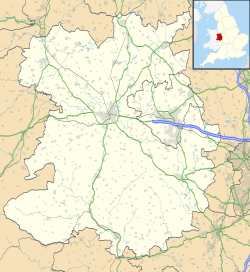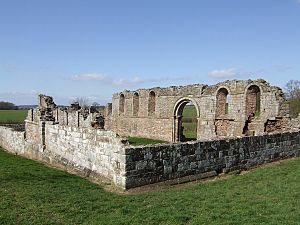White Ladies Priory facts for kids

Romanesque arch at White Ladies Priory.
|
|
| Monastery information | |
|---|---|
| Full name | St Leonard's Priory, Brewood |
| Other names | Convent of White Nuns |
| Order | Augustinian |
| Established | Mid-12th century |
| Disestablished | 1537/8 |
| Dedicated to | Leonard of Noblac |
| Diocese | Diocese of Coventry and Lichfield |
| Controlled churches | Montford, Shropshire Tibshelf Bold |
| People | |
| Founder(s) | Unknown |
| Important associated figures |
|
| Site | |
| Location | Near Brewood |
| Coordinates | 52°39′57″N 2°15′30″W / 52.6657°N 2.2584°W |
| Visible remains | Substantial remains of priory church. |
| Public access | Yes |
| Other information | Accessible all year at all reasonable times. A short walk from a minor road. |
White Ladies Priory (sometimes called Whiteladies Priory) was once a special kind of monastery for women. It was known as the Priory of St Leonard at Brewood. These women were called Augustinian canonesses, and they wore white clothes, which is how the priory got its name "White Ladies."
Today, the priory is in ruins in Shropshire, England. It's about 8 miles (13 km) northwest of Wolverhampton. The priory was closed down in 1536. It later became famous because King Charles II hid there in 1651 after a big battle.
Contents
What Was White Ladies Priory?
A priory is a type of monastery, which is a place where religious people live together. White Ladies Priory was home to Augustinian canonesses. These women followed the Rule of St. Augustine, which was a set of rules for living a religious life. They were sometimes called "nuns," but technically they were canonesses. They wore white religious clothes, which is why the place was called "White Ladies."
The priory was dedicated to Leonard of Noblac, a saint known for helping prisoners. This saint was very popular in the 12th century because people believed he performed miracles.
How Did the Priory Begin?
No one knows exactly when White Ladies Priory was started or who founded it. Most historians believe it was built in the mid-12th century (around the late 1100s). The oldest records mentioning the priory are from 1186. These records show that a woman named Emma gave land to the "white nuns of Brewood."
Even though it's called "Brewood Priory," the priory was never actually inside the village of Brewood. It was in its own special area nearby. Because no one claimed to be its founder, only the Bishop of Coventry and Lichfield had the power to make decisions about the priory.
Life at the Priory
The priory usually had five canonesses and a prioress, who was their leader. There were also servants, both religious and non-religious, who helped run the place. For example, in 1535, there was a seneschal (a manager) and a chaplain (a priest).
The canonesses lived a mostly quiet life inside the priory. However, the Augustinian rules allowed them more connection to the outside world compared to stricter groups like the Benedictines.
Sometimes, bishops would visit the priory to check on things. In 1326, Bishop Roger Northburgh had to step in when two canonesses left the priory. He even threatened to excommunicate them if they didn't return!
In 1332, the prioress, Joan de Hugford, resigned. Alice de Harley was chosen to replace her. Bishop Northburgh later visited again, probably in 1338. He told Prioress Alice off for spending too much money on fancy clothes and for keeping hunting dogs inside the priory! He also warned her not to let too many nuns join if the priory couldn't afford to support them. Alice died in 1349, around the time the Black Death arrived in Shropshire.
Priory Buildings
The church building at White Ladies Priory was made of sandstone and shaped like a cross. It had a main hall (called a nave) and a smaller area for the altar (called a chancel). The side parts (transepts) were small.
Today, you can still see the shape of the building, even though much of it is gone. The north wall of the nave and chancel is still quite complete. There's a beautiful round arch, typical of Romanesque architecture, that led into the north transept. This is where the canonesses would have walked to get to their living areas. The stone for the church probably came from nearby, perhaps even from a quarry that later became one of the priory's fish ponds.
Priory Lands and Money
White Ladies Priory received many gifts of land and money over the years. Even King John visited the priory and gave them fishing rights on the River Severn. They also owned land in places like Calverton and the church at Tibshelf in Derbyshire.
Owning a church meant the priory could collect tithes (a portion of people's income or crops) and hire a vicar to serve the church. This was a good way for the priory to earn money. However, they had to pay a large fine to King Edward II to get permission to take over the Tibshelf church.
The priory also received many small pieces of land from local families. Some of these were dowries when women joined the community. For example, Bartholomew Terret gave land for his sister Gundred.
Over time, the way land was managed changed. The priory had to fight in court to protect its right to use common pasture for its animals. After big events like the Great Famine and the Black Death in the 1300s, it became common to rent out land for very long periods at fixed prices. This meant that when prices went up later, the priory couldn't increase its rents. This made it hard for them to pay for repairs and other needs.
By the time the priory was closed, it owned land and property in many villages across Shropshire and other counties. The lands around Brewood and Montford were the most valuable.
The End of the Priory
By 1535, White Ladies Priory was not doing well financially. Its total income was only about £31 a year, which was very low. This meant it fell under the Dissolution of the Lesser Monasteries Act of 1536. This law, passed by Henry VIII, closed down all monasteries in England that were worth less than £200 a year.
Local rich families started trying to get their hands on the priory's land even before it was officially closed. Lord Stafford, for example, wanted to buy it. By May 1538, the priory was completely dissolved. The last prioress, Margaret Sandford, received a pension (regular payments) of £5 a year. The priory site itself was sold to William Whorwood and his wife Margaret in 1540.
After the Priory Closed
After the priory was dissolved, a man named William Skeffington built a house on the site. He might have used parts of the old prioress's residence. The property later passed to the Giffard family, who were important Recusants (Catholics who refused to attend Church of England services) and supported the king during the English Civil War.
In 1651, the priory belonged to Frances Cotton, a member of the Giffard family. It was being looked after by housekeepers and servants. Among the tenants on the estate were five brothers named Penderell, who were farmers and woodmen.
This is where the priory became famous! After the Battle of Worcester in 1651, King Charles II was trying to escape. Charles Giffard brought the king to White Ladies Priory early on September 4, 1651. George Penderell, a servant, let them in and sent for his brothers. After failing to cross the River Severn, King Charles returned to the area on September 6 and hid in the famous Royal Oak tree near Boscobel House, which was about a mile from White Ladies.
Frances Cotton died shortly after these events. White Ladies Priory and Boscobel House eventually passed to the Fitzherbert family. Although the house built on the priory site is now gone, the ruins of the medieval church and the old graveyard wall still remain. Today, English Heritage looks after these ruins, and you can visit them.
Prioresses of White Ladies Priory
Here is a list of some of the prioresses who led White Ladies Priory:
- Aldith (around 1225)
- Cecily (after 1225)
- Agnes (1254-1256)
- Sarah (1292)
- Joan (1315)
- Joan of Hugford (resigned 1332)
- Alice of Harley (elected 1332, died 1349)
- Beatrice de Dene (elected 1349)
- Margaret Corbet (1377-1381)
- Joan Fillilode (1409)
- Isabel Creghton (died 1463)
- Joan Shirley (elected 1463, active until 1484)
- Elizabeth Horde or Whorde (elected 1485, active until 1491)
- Alice Wood (elected 1491, resigned 1498)
- Margaret Cowper (elected 1498, active until 1504)
- Margaret Sandford (active from 1510 until the priory closed in 1538)





